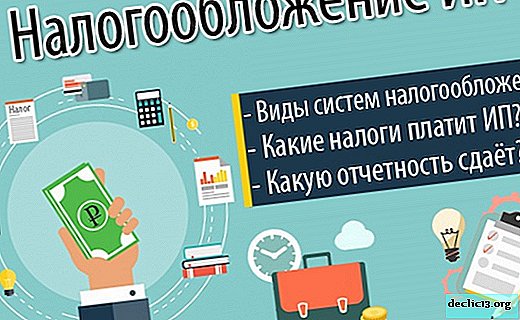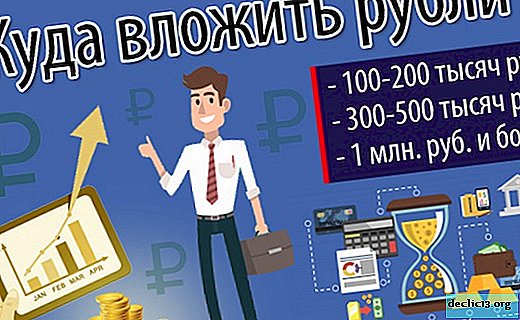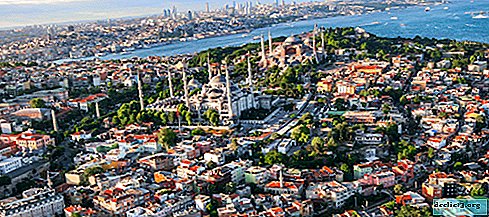IP taxation - what taxes and obligatory payments (fixed insurance premiums) do the IP pay for itself and employees in 2019
Hello dear readers of the magazine Rich Pro! Today we will talk about taxation of IP, namely: what tax systems there are what taxes does the individual entrepreneur pay? on each of the modes and what reporting must be taken by an individual entrepreneur.
In modern society, private enterprise has gained very wide popularity and has firmly secured the support of the state. There are many programs that promote small business development in various fields, and such a field as taxation, also did not stand aside.
For different categories of entrepreneurs, the choice of the most suitable and profitable regime tax paymentsdue to which, many young businessmen get a good incentive for growth and opportunities to start work in this area.
From this article you will learn:
- Which includes the concept of taxation itself in entrepreneurship and the types of systems offered;
- Why is the patent tax system so popular among aspiring entrepreneurs and is it so profitable;
- What taxes does the individual entrepreneur pay for DOS, USN, UTII, PSN and what kind of reporting an individual entrepreneur must submit;
- What are the deadlines for submitting reports for individual entrepreneurs and what are the mandatory (fixed) payments to the budget that an entrepreneur expects on different taxation systems.
This article will be useful as a beginner entrepreneur who just decided to open an IP, but also to those who are thinking about switching to another taxation system in order to reduce the tax burden.
Do you want to know all the details of paying taxes for 2019? Check out this topic in detail in our article!
 About types of taxation of individual entrepreneurs, insurance premiums and fixed payments, what taxes are paid and what kind of reports are submitted by an individual entrepreneur - read more
About types of taxation of individual entrepreneurs, insurance premiums and fixed payments, what taxes are paid and what kind of reports are submitted by an individual entrepreneur - read more
1. The concept and types of taxation systems IP (OSN, USN, PSN, UTII, ESKH) 📋
For each entrepreneur, one of the most crucial issues in building their own business is the definition of a tax system. It is she who establishes the procedure for the further work of the individual entrepreneur, payment of duties, and how difficult accounting and tax accounting will be.
Within the framework of the tax legislation of the Russian Federation, at present IP can choose for itself one of the following systems and modes:
- General mode (OCH);
- UTII or the imputed system;
- Simplified System (USN);
- Patent System (PSN);
- Unified Agricultural Tax (UPC).
The general regime is provided for all individuals and obliges them to pay tax on all their income. UTII is applied by entrepreneurs who have chosen a particular type of activity, including agriculture, and are obligated to pay a fee to the budget in the form of a single tax on imputed income. STS, in turn, allows you to remove the burden of paying certain types of payments, replacing them with a single one.
💡 All tax payments, as well as the corresponding statements, must be submitted in a specific order and within the deadlines strictly established by law. Otherwise, unpaid taxes may be collected by the tax authority in a forced manner, by seizing personal property, with the permission of the court.
Each of the taxation systems needs to be considered in more detail.
1.1. UTII taxation system (Single imputed income tax)
When an entrepreneur uses UTII, he is not required to pay taxes such as Personal income tax, Unified social tax, VAT and other types that are replaced by a single tax on imputed income. Remaining payments like taxand insurance and retirement the entrepreneur pays for other modes.

You can highlight certain conditions that allow the use of UTII:
- Place of business. Such a system does not operate in all regions of the country, but only where it is established by legislative and regulatory acts;
- Kind of activity. The list of such species is set separately in each region;
- Lack of contracts trust management or simple partnership;
- Participation of other organizations in carrying out activities not higher than 25%.
- The organization is listed no more 100 employees;
- There are larger taxpayers in the region.
Earlier, the abolition of this tax payment system was planned for early 2018, but by Presidential Decree on June 2, 2016, the UTII application period was extended until January 1, 2021, due to its demand among small businesses.
The types of activities for which the application of UTII is permitted are determined by law and currently include:
- retail trade;
- catering enterprises;
- domestic services;
- veterinary services;
- Car repair, maintenance and washing;
- advertising;
- temporary residence services;
- and others.
It is important to notethat until January 1, 2017, domestic services were determined according to the OKUN classifier, which now has ceased to function. The list of such services is established by the OKVED2 and OKPD2 directories, and the new list is presented by Decree of the Government of the Russian Federation No. 2496-r dated 11.24.2016.
Among them, still, servicesaimed at repairing shoes, clothes, watches, household appliances, the issuance for temporary use of sports equipment, as well as personal items and more. However, new types of services were added that were not previously considered domestic, for example, the manufacture of furniture for a personal order.
1.2. Tax System USN (Simplified tax system)

If an individual entrepreneur chooses a simplified system, then he exempts himself from paying certain types of tax (Personal income tax, property tax) replaced by a single tax (EH), which is calculated from the calculation of the results of the organization. The remaining payments, including insurance, paid on general terms.
Important! Such a system operates and can be applied throughout the country, and you can switch to it at the beginning of next year, announcing this in advance in the current year.
In this case, the legislation provides for a free and voluntary transition from a simplified taxation system and a return to it from other systems.
However, for the use of STS there are some limitations.
First of all, by income, the amount of which has changed since January 1, 2017, which allowed to expand the application of the regime for small businesses, due to the fact that:
- The maximum income received by an organization wishing to switch to the simplified tax system since 2017 has been increased up to 120 million rubles (previously 60 million);
- The revenue limit for 9 months of the current year (which states the planned change in the tax system) has also doubled - 90 million rubles, against 45 earlier.
- The allowable value of the residual price of fixed assets of the organization increased from 100 million up to 150 million rubles.
It is worth mentioning that the application of the simplified tax system is not available to all taxpayers. do not have the right to go to it:
- firms with more than 100 people;
- organizations with additional units;
- firms in which the percentage of participation of other firms over 25;
- entrepreneurs paying a single agricultural tax;
- private lawyers and notaries;
- credit organizations, pawnshops, pension funds, insurance companies and others;
- gambling business;
- organizations active in the securities market;
- budgetary institutions;
- firms from other countries;
- private job search agencies;
- organizations sharing products with other organizations.
Therefore, the above limitations should be taken into account when switching to the simplified tax system or opening a new IP with such a taxation system.
For more information about the simplified taxation system for entrepreneurs, see the article here.
1.3. DOS tax system (General tax system)

An individual entrepreneur using a common taxation system is required to make fee for all established tax paymentsrelated to it, on a general basis, unless, of course, it has an exemption from a particular tax burden, which may be determined by authorized tax authorities.
When using this mode, the entrepreneur will have to pay the following payments:
- Individual income tax (PIT) - the main of direct taxes, is a percentage of the total income from which expenses that are documented are deducted
- Value added tax (VAT) - an indirect tax paid with that component of the value that was added to the price of the goods at all stages of its production and sale, after it reaches the final consumer.
- Various duties - all kinds of fees, under the law, levied on the importation of goods into the country or the commission of other significant actions;
- Excise taxes - a payment assigned to a certain category of goods, included in their value and not depending on the income received;
- Mining tax - payments for the development of natural resources;
- Fees for the use of wildlife and water paid by entrepreneurs with special needs for water use or animal participation;
- Transport tax, land - fees from owners of vehicles and land;
- Property tax - payment, depending on the cadastral value of the property;
- Gambling Tax - increased tax payments when generating income from gambling.
Accordingly, the majority of contributions to the budget apply only to organizations operating in a particular area, while most businessmen are taxed only with basic taxes, such as Personal income tax, VAT and other.
Important! If entrepreneurs, in connection with the peculiarities of their activities, need to document the value that has been added (for buyers), then this tax regime for them is most suitable.
One of the most important features of cash flow accounting, when individual entrepreneurs use the general taxation system, is the application in this accounting cash service.
It is more convenient for individual entrepreneurs to pay personal income tax, the amount of which can be reduced due to the amount of professional contributions and deductions, while legal entities are taxed on income.
For each enterprise, the choice of the tax system is individual, due to the strengths and weaknesses of each of them and the specifics of the business. However, for successful operations it is necessary to accurately and timely calculate and pay tax contributions.
 Taxation system for individual entrepreneurs - PSN
Taxation system for individual entrepreneurs - PSN
1.4. PSN tax system (Patent tax system)
The patent system of taxation (PSN) differs from other regimes, primarily in that it does not require a tax return, and the tax is calculated at the time when it is paid patent - documentary evidence of the right to carry out one of the types of entrepreneurial activity in a certain territory.
A patent is acquired for a term no more than 12 months and convenient for those who want to identify demand and needs in a particular sales region, having tested, for example, a small business at the initial stage.
Who can switch to PSN?
Not all entrepreneurs can use the right to transfer to PSN, but only those that carry out certain types of activities. Their list, for the most part, corresponds to the list of permitted activities at UTII, limited to a range of services and directions of retail trade.
What types of activities fall under the patent taxation system for IP?
Basically, production activity, as such, is not included in the list of types of entrepreneurship that allow the use of preferential regimes, but production services are quite acceptable.
The patent regime can even carry out procedures for the manufacture of goods such as carpets and rugs, felted shoes, handicrafts, sausages, agricultural implements, coopers, pottery, eyewear optics, wooden boats and business cards. That is, you can summarize all these types, such as a craft or a small production with your own hands.
At the moment, a list of activities that are allowed to use SPEs, not changed since January 1, 2016is determined by article 346.43 of the Tax Code of the Russian Federation and includes 63 items. However, this year D.A. Medvedev a bill was introduced allowing use of PSN for all types of entrepreneurial activity. In addition, regional authorities have the right to expand the list of public services for OKCH in their territory.
What are the limitations for the use of PPS?
There are some restrictions associated with the transition to the patent tax system:
- the mode is available only to individual entrepreneurs;
- the staff of IP can be no more than fifteen people;
- PSN cannot be applied if partnership or trust agreements are in force;
- in case of excess of the amount of income from patent activities of 60 million rubles, IP loses its patent right. When combined with the simplified tax system, revenues are taken into account in the amount of two modes.
In what area is the patent valid?
In accordance with Law No. 244-FZ of 07.21.14 from 2015, with the exception of patents for road transport and retail distribution, the region of validity of a patent limited to municipalitythat allows you to more fairly calculate the cost of such a right, but limits the area of its application.
What determines the cost of a patent and how is it calculated?
Patent price - it is a fixed cost, which makes it profitable to use when significant amount of income and vice versa, if the income level is low. The regional authorities set the potential annual income (VHW) for each type of activity in a given territory, which acts as a tax base in this regime, and the tax rate in the amount of 6%is calculated on the basis of this value.
The maximum value of such an indicator - about1 million rubles, and the minimum bar is missing from 2015.
In the calculation of PSN, a concept such as deflator, adjusting the value of the PVGD depending on changes in prices in the previous period throughout the country. This is a fixed value set for the next year.
In 2019, this coefficient was set to 1.518 (in 2018 it was1,481)accordingly, the maximum value of PVGD for PSN is 1,518 thousand rubles.
However, it is worth noting that each region has the right to increase the PVGD up to 10 times:
- for trucking and maintenance of automobile transport - up to 3 (three) times;
- for any patent activities in cities with a population of more than 1 million people - up to 5 (five) times;
- for rental services for real estate, catering and retail up to 10 (ten) times.
In special cases, the number of employees, the size of the trading room or the room where the service is performed, the number of vehicles, the area for rent, etc. may be important for calculating a patent.
Pros and Cons of the Patent Tax System
Among the advantages of the patent tax system are the following:
- relatively low, in most cases, patent fees;
- independent choice of the term for applying the patent (1-12 months);
- the right to acquire several patents at once in different regions or to several types of activities;
- lack of a report by filing a tax return, as a result, saving time and costs arising from its submission and verification;
- with the exception of patents for catering services, retail trade and the provision of rental real estate, social security contributions for employees are not paid in 2019. All that remains is pension and medical insurance, in the amount of 20% of the salary accrued by him.
- unlike the UTII system, the list of patent activities by local governments can only be expanded. They have no right to cut it.
The negative sides of the patent tax system are:
- the accessibility of the transition to this mode is only for individual entrepreneurs, and legal entities do not have the right to work under the PSN;
- limited list of acceptable types of activities in services and retail trade in small volumes;
- the most stringent headcount restrictions are no more than 15 employees on all types of IP activities;
- when working in retail or catering, the maximum working area of the hall is 50 square meters, while at UTII such an area is three times larger;
- to control the income received by the entrepreneur from patent activity, which should not exceed 60 million rubles, you need to keep a special book of revenue accounting for this system;
- tax, in the form of a constant patent value, is paid before the tax period ends, and not after the receipt of income;
- the inability to reduce the amount of patent value by the amount of insurance premiums that were paid for the employees, while at the STS or UTII this possibility is present. However, when using the modes together, the individual entrepreneur has the right to take into account payments for himself when calculating the amount of a single or imputed income.
1.5. Taxation system of the Unified Agricultural Tax (Unified Agricultural Tax)

The essence of the CES regime is to reduce the tax burden foragricultural producers, organizations for its processing, sale, storage, various fish farms.
The full list is defined in clause 2.1. Chapters 346.2 of the Tax Code of the Russian Federation, however, amendments came into force on 01/01/2017, according to which the list became wider.
If the organization has more 70% makes up the share of services provided to agricultural producers, then such organizations (including private entrepreneurs) are also entitled to use this tax payment regime.
This right is deprived of companies with additional units producing excisable goods doing business in the region gambling, various budgetary institutions.
The benefit for an individual entrepreneur from this regime consists in exemption from payment of such tax payments as:
- property tax, which is not determined by the cadastral value;
- Personal income tax;
- VAT (excluding imports).
The rate of this tax is 6% and is calculated on the basis of the base, which is the actual difference between the values of income and expenses.
 What taxes should an individual entrepreneur pay on USN, UTII, PSN, OCH
What taxes should an individual entrepreneur pay on USN, UTII, PSN, OCH
2. What taxes does the individual entrepreneur pay - the latest data on the payment of individual entrepreneur taxes (without employees, with employees) 📰
When conducting any activity by an individual entrepreneur, payment of mandatory tax payments and contributions to the budget is an important condition for work.
Depending on the chosen taxation system, after the registration of an individual entrepreneur, it is necessary to take into account all future costs of these payments.
In general, entrepreneur payments to the budget can be classified as follows:
- Income taxes, depending on the taxation system, which is chosen as the main;
- Taxes on property, transport and land used in business;
- Insurance premiums.
Some activities of entrepreneurs are required to pay additional taxes, among them the following can be distinguished:
- tax for the use in their activities of water resources or facilities;
- tax paid by firms that exploit and use natural resources;
- tax on the sale of excisable goods or their manufacture.
In addition, enterprises that receive special licenses or permits are forced to pay not only taxes, but also fees for their application.
Property tax
Entrepreneurs using special tax systems are required to pay tax on property used in their activities, although this was not previously required. This includes real estateand listed in the local cadastral list.
Accordingly, when an individual entrepreneur possesses property that is on the list of objects for which the tax base is determined based on the cadastral value and uses it in his activities, he will have to pay this tax. The selected tax payment system, in this case, does not play a role.
A detailed list of such objects is available on the official Internet portal of the Federal Tax Service or a regional Internet resource, for which local executive bodies are responsible.
It may include categories such as:
- centers of administrative business activity;
- shopping centers of the region;
- specific facilities in these centers;
- premises that are not used as residential and designed to accommodate retail space, various offices, premises for the provision of catering and consumer services, in accordance with the passports of cadastral registration of real estate or technical documentation of such objects. Also in this category are premises that are actually used for these purposes, but can be classified as residential.
Land tax
Upon tax notification, individuals are required to pay land use taxthat are used in business activities. Such notifications should be sent no less than 30 days before the due date. They specify in detail the tax itself, which must be paid and the calculation of the tax base.
In cases of non-receipt of such a notification, it is necessary to contact the tax office personally in order to avoid missing the payment date and further proceedings.
Usually, the payment deadline is set until October 1, with the exception of Moscow and St. Petersburg, which are entitled to change the terms and procedure for paying land tax.
2.1. What taxes does the SP pay on DOS
If an entrepreneur does not require or is unavailable for one reason or another, switching to any of the preferential tax systems, he is taxed by default in accordance with the DOS. Often, in this mode, paying all taxes is simply unprofitable.
Obligatory to pay are:
- value added tax (VAT) in the amount of 0%, 10% or 18%, depending on the product (tax may be removed, formally designated as a zero interest rate);
- personal income tax (PIT) accrued on employee income in the amount of 13%;
- Personal income tax on the activities of the entrepreneur himself is also 13%;
- land tax 0,3% or 1,5%;
In cases when entrepreneurial activity is suspended, taxes are not required. This is an undoubted advantage of this mode.
2.2. What taxes does the individual entrepreneur pay for USN
The simplified tax system is most popular among entrepreneurs, due to the fact that it has a minimum amount of mandatory tax payments.
There are 2 (two) types of STS with different interest rates:
- tax base is calculated based on the total income of the company (rate 6%);
- the tax base is calculated based on the amount of profit received (rate 15%).
This mode requires simple accounting. The big advantage is that the tax burden can be reduced due to previously paid insurance premiums, and in the event of suspension of activity - taxes can not be paid.
If staff are available, pay 13% personal income tax from their salary.
2.3. What taxes does the FE pay on UTII
When using the UTII system (for certain types of activity, such as retail trade, public catering, repair services, etc.), the tax rate is set at 15%and VAT is not charged.
It is worth recalling that the possibility of using this regime is established by the regional authorities, which determine the size of the estimated income.
2.4. What taxes does an individual pay on PSN
If an entrepreneur has irregular financial income, it will be more profitable for him to switch to a patent taxation system. In this mode, the patent is paid to the budget, which is fixed. Depending on the region and the activity, it is not established by local authorities.
At the same time, financial statements and a cash register are not required, which is an undoubted advantage.
Such a regime is especially convenient for seasonal business, because the term of a patent is chosen voluntarily.
Also, with this system, it is necessary to list insurance premiums both for yourself and for all employees for whom you still need personal income tax transfer.
 How and what reporting is submitted by an individual entrepreneur
How and what reporting is submitted by an individual entrepreneur
3. What reporting should an individual entrepreneur submit предприниматель
Each entrepreneur is required to submit tax reports to the appropriate authorities on time and in accordance with the rules established by law.
The reports that must be submitted to the entrepreneur are determined, first of all, by the chosen taxation regime, as well as by the presence of employees in the organization, the use of cash registers and the type of activity.
Among the reports submitted by entrepreneurs, four conditional categories can be distinguished:
- reporting relevant to the selected tax regime;
- reporting for employees, if any;
- reporting of cash transactions, if applicable;
- additional tax reporting.
IP reporting deadlines
The law establishes strict deadlines for filing tax reports, which depend on the chosen taxation regime.
Due to the fact that since 2018 insurance premiums for employees are controlled by the tax service, reports on them will be submitted quarterly, within 30 days of the next month.
4. A summary table on taxation, reporting and restrictions of individual entrepreneurs
Here is a general table on taxes paid by individual entrepreneurs, reports, restrictions, etc. depending on the tax regime.
| IP mode | Short description | Tax payment | Payment | Reporting | Staff restrictions |
| DOS | Basic tax set by default | Depends on income | Every quarter | - | |
| STS | The most popular heart failure in firms with fewer than 100 employees. | 6% from all income (profitable if expenses are small) | In the absence of income - not paid | Once a year surrendered to the tax book of income-expenses | No more 100 hired workers. |
| 15% from profit (difference in income and expenses), i.e. convenient for large confirmed costs | |||||
| UTII | It is used in trade and services by a limited list of IPs, depending on the activity. | Single tax that can be reduced by contributions paid | Paid even with a simple organization | Keeping records is simple, the rate depends on the type of activity, the number of employees, area and other parameters. Costs are not taken into account. | No more 15 workers |
| PSN | Fixed patent value | No more 15 hired workers. |
As can be seen from the table, depending on the choice of taxation regime, the amount of tax, staff restrictions, type of reports submitted, and so on depends.
5. Features of filling and submitting reports IP 📄
Consider some features of reporting.
1) SP without employees on DOS
The table provides information on reporting documents, deadlines for submission and payment:
| Name of the reporting document | Due date | Reporting deadline |
| 3-personal income tax | until July 15 | until April 30 |
| VAT declaration | until the 25th day of the month following the billing quarter | until the 25th day of the month following the billing quarter |
| Indirect Tax Declaration | during customs clearance | until the 20th of the next month |
| 4-personal income tax | payment after filing a declaration | up to 1 month + 5 days from the receipt of revenue |
The 3-personal income tax return reflecting taxes on personal income can be filled out and filed in person, by mail on paper or via the Internet. While the report on VAT is submitted strictly in electronic form.
The indirect tax return is filled in if the company imports goods from the countries that are members of the customs union.
Form 4-personal income tax reflects the expected income of individuals and is used to determine the prepayment for personal income tax. It must be submitted if the proceeds appeared during the first “profitable” year or the expected income has changed by an amount greater than 50%.
In each quarter, advance payments (AP) for personal income tax are carried out, which is presented in the table:
| Due date | The size |
| until July 15 of the current year | ½ of the amount of AP for the year (January-June) |
| no later than October 15 of this year | ¼ of the amount of AP for the year (July - September) |
| until January 15 of next year | ¼ of the amount of AP for the year (October-December) |
Until December 1 of next year, it is necessary to pay tax on property of individuals, according to the notification of the FTS.
If an individual entrepreneur owns a plot of land, then he will also have to pay tax and file a corresponding declaration before February 1 of next year. This applies only when the property is involved in entrepreneurial activity.
2) SP without employees on the simplified tax system
Advance payments for the year on the simplified tax system are made every quarter before 25 the numbers following the quarter of the month. And the fee itself is paid until April 30, and then reports on it.
VAT on the simplified tax system it is calculated if the quarter acted as a tax agent or imported products from the customs union, in terms similar to DOS. If VAT is set at the initiative of the entrepreneur, reporting and payment is carried out before 25 the numbers months after the reporting quarter.
An entrepreneur on a simplified tax system does not pay tax on property involved in activities, except in cases where the tax base for this type of property, as designated by regional authorities, is calculated on the basis of the cadastral value.
Personal income tax on the simplified tax system entrepreneur also not pays. All other payments are made in the same manner as DOS.
3) SP with employees
Entrepreneurs with staff submit a form 2-personal income tax until April 1 next year.
In addition, they pay contributions to the FSS:
- until the 20th day of the next month in paper form;
- until the 25th day of the next month in electronic form.
Calculation must be provided before 30 the numbers following the reporting quarter of the month.
Personnel data served until January 20 next year. PIT, which is withheld from employee earnings, is paid once a month, the sequence and time limits of this calculation are determined by Art. 226 of the Tax Code of the Russian Federation.
6. The book of accounting for income and expenses (KUDIR) for IP 📓
Individual entrepreneurs operating under any of the taxation systems are required to conduct KUDIR, Besides businessmen choosing a regime UTII, which take into account only physical indicators and are not forced to record information about financial flows.
Such a book is kept by the entrepreneur in a stitched and numbered form. She does not require certification.Although here there is one exception - USCH regime. When using this system, it is mandatory to approve the Book by the signature of the responsible official and the seal of the tax authority before proceeding with its maintenance on paper or until March 31following the reporting, if accounting is done in electronic format.
Failure to comply with these requirements and the absence of the Book is punishable penalties.
Reporting IP on additional taxes IP
An individual entrepreneur may conduct activities subject to additional taxes, the deadlines for reporting on which are presented in the table:
| Tax | Reporting | Deadlines |
| Land tax | Declaration | until February 1 of next year |
| Water Use Tax | Declaration | no later than the 20th day of the month following the quarter |
| Excisable goods tax | Declaration | no later than the 25th day of each next month |
| Advance Payment Notice | until the 18th day of each current month | |
| Mineral Extraction Tax (MET) | Declaration | no later than the beginning of next month |
| Fees for the use of wildlife | Permission Details | within 10 days from the receipt of permission |
| Fees for the use of aquatic biological resources | Information on Permits and Fees Received | within 10 days from the receipt of permission |
| Information about the number of objects | no later than the 20th day of the following month after the expiration of the permit | |
| Regular payments for the use of subsoil | Recurring payments | no later than the end of the month following the reporting quarter |
The table lists the types of taxes with parameters by type of reporting and its timing.
 Insurance premiums and fixed payments of FE for themselves and employees
Insurance premiums and fixed payments of FE for themselves and employees
7. Mandatory contributions and fixed payments of individual entrepreneurs (for themselves, for employees) in 2019 💸
Consider the mandatory and fixed payments for individual entrepreneurs (for themselves and employees) in more detail and in detail.
7.1. Fixed contributions to the FIU
Individual entrepreneurs are required to pay contributions to the MHIF and the Pension Fund, which are fixed by law. In 2019, they will amount to: in the PFR - 29,354 rubles. and in the MHIF - 6,884 rubles. Payment is made once a quarter or once a year.
In the case when the income for the year has become higher than 300 thousand rubles, it is additionally paid 1% from the excess amount until April 1 of the following year.
Insurance premiums for individuals (for themselves, employees) in 2019
Since 2017, all insurance contributions are controlled by the Federal Tax Service, and not the Federal Tax Service is paid even if the organization no profit or loss. By this amount it will be possible to reduce the tax for the simplified tax on income, which is set at 6% of income.
Important! Fixed contributions for the year are now not tied to the minimum wage.
Payments for IP in the MHIF
In the Federal Fund for Obligatory Medical Insurance, IE in 2019 must pay a constantly established contribution in the amount of 6 884 rub. per year.
If the income for the entrepreneur’s year of work below 300 thousand rubles, paid only two payments for themselves, which together make up 36 238 rubles. If the income has crossed the established line, an additional charge 1% of the excess amount (under the PSN regime, 1% is levied on the potential income).
All taxes and insurance premiums for themselves are paid by the IP by filling out a payment document inMHIF, FIU and Federal Tax Service(receipt or payment order).
7.2. The order of payment of fixed insurance premiums IP
Fixed insurance premiums are paid by filling out a form PD number (tax) or No. PD-4sb (tax) from the settlement account of an individual entrepreneur or through Sberbank.
In cases when IP is registered not at the beginning of the year, but later, then contributions are paid only for this period.
However, they are paid even if the entrepreneur combines business with employment and the employer has already paid contributions for him as an employee.
7.3. Reporting on fixed payments of IP
Despite the fact that for a long time (since 2012) the reporting for making fixed payments by the entrepreneur for himself (if he works without staff) has been canceled, payment receipts must be kept. An additional saving may be the possibility of reducing the amount of tax on the simplified tax system for income by the amount of contributions paid.
Such insurance premiums are calculated depending on the size of the minimum wage as of January 1 of the current year and are unchanged, even if the minimum wage is adjusted subsequently.
8. Conclusion + video on the topic 🎥
Tax accounting, timely reporting and payment of contributions are an integral part of any business, including private enterprise.
Depending on the chosen taxation regime, on the type of business and the income received, tax rates may vary or be removed from the entrepreneur altogether. However, proper accounting is necessary in any tax system.
Thanks to this article, you have become familiar with the types of tax payment regimes, their distinguishing features, limitations and reporting deadlines. Now you can determine the most favorable conditions for making payments to the budget and choose the appropriate taxation system. The complexity of accounting and the costs associated with the conduct of your chosen activity directly depend on this.
In conclusion, we recommend that you watch the video, which briefly describes about types of taxation IP and how to choose a tax system:

Dear readers of RichPro.ru magazine, we will be grateful if you share your wishes, experiences and comments on the topic of publication in the comments below. We wish you prosperity in the business sector.

















